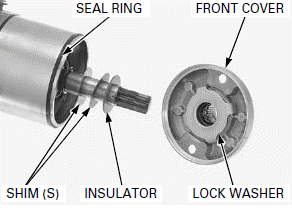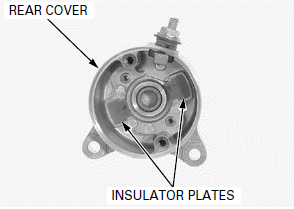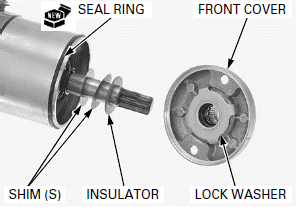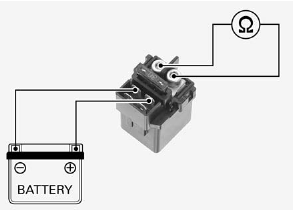 Honda CBR125RW - Service manual > Electric Starter
Honda CBR125RW - Service manual > Electric Starter
SYSTEM LOCATION

- IGNITION SWITCH
- CLUTCH SWITCH
- STARTER SWITCH
- STARTER RELAY SWITCH
- DIODE
- MAIN FUSE (30 A)
- BATTERY
- STARTER MOTOR
- NEUTRAL SWITCH
- SIDESTAND SWITCH
- SUB FUSE
SYSTEM DIAGRAM

SERVICE INFORMATION
GENERAL

If the current is kept flowing through the starter motor turn it while the engine is not cranking over, the starter motor may be damaged.
- The starter motor can be serviced with the engine installed in the frame.
- Always turn the ignition switch OFF before servicing the starter motor. The motor could suddenly start, causing serious injury.
- A weak battery may be unable to turn the starter motor quickly enough, or supply adequate ignition current.
- When servicing the starter system, always follow the steps in the troubleshooting flow chart.
- Refer to the following components information:
- Ignition switch
- Starter switch
- Engine stop switch (CM and U type)
- Neutral switch
- Sidestand switch
- Clutch switch
SPECIFICATION

TROUBLESHOOTING
Starter motor does not turn
1. Fuse Inspection
Check for blown main fuse or sub fuse.
Is the fuse blown?
YES - Replace the fuse.
NO - GO TO STEP 2.
2. Battery Inspection
Make sure the battery is fully charged and in good condition.
Is the battery in good condition?
YES - GO TO STEP 3.
NO - Charge or replace the battery.
3. Starter Relay Switch Operation
Check the starter relay switch operation.
You should hear the relay "CLICK" when the starter switch button is depressed.
Is there a "CLICK"?
YES - GO TO STEP 4.
NO - GO TO STEP 5.
4. Starter Motor Inspection
Apply battery voltage directly to the starter motor and check the operation.
Does the starter motor turn?
YES -
- Poorly contacted starter motor cable
- Faulty starter relay switch
NO - Faulty starter motor.
5. Relay Coil Ground Lines Inspection
Disconnect the starter relay switch connector, and check the relay coil ground wire line as below for continuity:
1. Green/red terminal - diode - neutral switch line (with the transmission in neutral and clutch lever released).
2. Green/red terminal - clutch switch - sidestand switch line (in any gear except neutral, and with the clutch lever pulled in and sidestand up.
Is there continuity?
NO -
- Loose or poor contact connector
- Open circuit in wire harness
- Faulty starter switch
- Faulty sidestand switch
- Faulty diode
- Faulty clutch switch
- Faulty neutral switch
YES - GO TO STEP 6.
6. Starter Relay Input Voltage Inspection
Connect the starter relay switch connector.
With the ignition switch ON (and engine stop switch " ":
CM and U type), measure the voltage at the starter relay switch connector
(between Yellow/red (+) and ground (-)).
":
CM and U type), measure the voltage at the starter relay switch connector
(between Yellow/red (+) and ground (-)).
Does the battery voltage exist?
NO -
- Faulty ignition switch
- Faulty starter switch
- Engine stop switch (CM and U type)
- Loose or poor contact connector
- Open circuit in wire harness
YES - GO TO STEP 7.
7. Starter Relay Switch Continuity Inspection
Remove and check the operation of the starter relay switch.
Is there continuity?
NO - Faulty starter relay switch
YES - Loose or poor contact starter relay switch connector
The starter motor turns when the transmission is in neutral, but does not turn with the transmission in any position except neutral, with the sidestand up and the clutch lever pulled in.
1. Clutch Switch Inspection
Check the clutch switch operation.
Is the clutch switch operation normal?
NO - Faulty clutch switch
YES - GO TO STEP 2.
2. Sidestand Switch Inspection
Check the sidestand switch operation.
Is the sidestand switch operation normal?
NO - Faulty sidestand switch.
YES -
- Open circuit in wire harness
- Loose or poor contact connector
Starter motor turns slowly
- Low battery voltage
- Poorly connected battery terminal cable
- Poorly connected starter motor cable
- Faulty starter motor
- Poorly connected battery ground cable
Starter motor turns, but engine does not turn
- Starter motor is running backwards
- Case assembled improperly
- Terminals connected improperly
- Faulty starter clutch
- Damaged or faulty starter idle gear and/or reduction gear
Starter relay switch "Clicks", but engine does not turn over
- Crankshaft does not turn due to engine problems
STARTER MOTOR
REMOVAL
Remove the lower cowl.
With the ignition switch OFF, remove the negative (-) cable at the battery before servicing the starter motor.
Release the rubber cap.
Remove the starter motor terminal nut and starter motor cable.
Remove the stater motor mounting bolts and ground cable.
Remove the starter motor.

Remove the O-ring.

DISASSEMBLY/INSPECTION
Remove the starter motor case bolts and O-rings.

Record the location and number of shim (s).
Remove the front cover, insulator, shim (s) and seal ring.
Remove the lock washer from the front cover.

Record the location and number of shim (s).
Remove the rear cover, shim (s) and seal ring.
Remove the armature from the motor case.

Remove the brushes and springs from the brush holder.

Check the oil seal of the front cover for deterioration or damage.
Check the needle bearing for wear or damage.
Replace the starter motor as an assembly if necessary.

Do not use emery or sand paper on the commutator.
Clean the metallic debris off between commutator bars.
Check the commutator bars of the armature for discoloration, wear or damage.
Replace the starter motor as an assembly if necessary.

Check for continuity between pair of commutator bars.
There should be continuity.

Check for continuity between each individual commutator bar and the armature shaft.
There should be no continuity.

Check for continuity between the positive brush and cable terminal.
There should be continuity.

Check for continuity between the positive brush and rear cover.
There should be no continuity.

Remove the screws, washers, negative brush and brush holder from the rear cover.

Remove the insulator plates from the rear cover.

Remove the following:
- Nut
- Washer
- Insulators
- O-ring

Remove the positive brush and set plate.

Measure the brush length.
SERVICE LIMIT: 3.5 mm (0.14 in)

Check the bushing of the rear cover for wear or damage.
Replace the starter motor as an assembly if necessary.

ASSEMBLY

Install the set plate and brush into the rear cover.

Install a new O-ring, insulators, washer and nut.
Tighten the nut securely.

Install the insulator plates onto the rear cover.

Install the brush holder, negative brush, washers and screws into the rear cover as shown.
Tighten the screws.

Apply engine oil to the oil seal lips.

Install the armature into the motor case while holding the armature shaft tightly to keep the magnet of the motor case from pulling the armature shaft against it.

The coil may be damaged if the magnet pulls the armature against the motor case.

Install the springs and brushes to the brush holder.

Install a new seal ring to the motor case.
Install the same number of shim (s) in the same locations as noted during disassembly.
Install the shim (s) onto the armature shaft.
Install the rear cover while pushing the brushes into the brush holder and aligning the brush set plate tab with the motor case groove.

Install the same number of shim (s) in the same locations as noted during disassembly.
Install the shim (s) and insulator.
Install a new seal ring to the motor case.
Install the lock washer to the front cover.
Install the front cover.
- When installing the front cover, take care to prevent damaging the oil seal lip with the armature shaft.

Align the index lines on the covers and motor case.
Install new O-rings onto the motor case bolts.
Install and tighten the starter motor case bolts securely.

INSTALLATION
Apply engine oil to a new O-ring and install it into the starter motor groove.

Route the cable properly.
Install the starter motor into the crankcase from the right side.
Install the ground cable and starter motor mounting bolts.
Tighten the mounting bolts securely.
Install the starter motor cable and starter motor terminal nut.
Tighten the terminal nut securely and reposition rubber cap properly on the starter motor terminal.
Install the lower cowl.

STARTER RELAY SWITCH
INSPECTION
Remove the single seat.
Shift the transmission into neutral.
Turn the ignition switch ON (and engine stop switch " ":
CM and U type).
":
CM and U type).
Push the starter switch.
The coil is normal if the starter relay switch clicks.
If you don't hear the starter relay switch "CLICK", inspect the starter relay switch using a procedure below.

GROUND LINE
Disconnect the starter relay switch 4P (Red) connector.
Check for continuity between the Green/red wire of the wire harness side (ground line) and ground when the starter switch button is pushed.
If there is continuity when the transmission is in neutral or when the clutch is disengaged and the sidestand is retracted, the ground circuit of the relay coil is normal. (In neutral, there is a slight resistance due to the diode.)

STARTER RELAY INPUT VOLTAGE
Connect the starter relay switch 4P (Red) connector.
Turn the ignition switch ON (and engine stop switch " ":
CM and U type).
":
CM and U type).
Measure the voltage between the Yellow/red (+) wire terminal at the starter relay switch 4P (Red) connector and ground (-).
If the battery voltage appears only when the starter switch is pushed with the
ignition switch ON (and engine stop switch " ":
CM and U type), the starter relay input voltage is normal.
":
CM and U type), the starter relay input voltage is normal.

OPERATION CHECK
Remove the starter relay switch.
Connect a 12 V battery to the starter relay switch as shown.
There should be continuity between the cable terminals when the battery is connected, and not continuity when the battery is disconnected.

REMOVAL/INSTALLATION
Remove the rear cowl.
Release the rubber cover.
Disconnect the starter relay switch 4P (Red) connector.
Remove the bolts and disconnect the starter and ground cables.
Remove the starter relay switch from the stays with the shock rubber.
Remove the starter relay switch from the shock rubber.
Installation is in the reverse order of removal.

DIODE
INSPECTION
Remove the rear cowl.
Remove the diode.

Check for continuity between the diode terminals.
When there is continuity, a small resistance value will register.
If there is continuity in one direction, the diode is normal.

See also:
 Honda CBR125RW - Service manual > Ignition System
Honda CBR125RW - Service manual > Ignition System
SYSTEM LOCATION CLUTCH SWITCH IGNITION SWITCH IGNITION COIL ECM INJECTOR MAIN FUSE (30 A) BATTERY SUB FUSE SIDESTAND SWITCH NEUTRAL SWITCH CKP SENSOR SPARK PLUG
 Honda CBR125RW - Service manual > Lights/Meters/Switches
Honda CBR125RW - Service manual > Lights/Meters/Switches
SYSTEM LOCATION CLUTCH SWITCH COMBINATION METER IGNITION SWITCH FRONT BRAKE LIGHT SWITCH RIGHT HANDLEBAR SWITCH FUEL PUMP UNIT ECT SENSOR TURN SIGNAL RELAY MAIN RELAY REAR BRAKE LIGHT SWITCH SIDESTAND SWITCH NEUTRAL SWITCH HORN LEFT HANDLEBAR SWITCH

 BMW G310GS
BMW G310GS Honda CBR125RW
Honda CBR125RW Husqvarna 401 Vitpilen
Husqvarna 401 Vitpilen KTM 890 Duke R
KTM 890 Duke R Mash Dirt Track 650
Mash Dirt Track 650 Peugeot Kisbee
Peugeot Kisbee Yamaha Tracer MT-09
Yamaha Tracer MT-09 Honda CBR125RW
Honda CBR125RW Peugeot Kisbee
Peugeot Kisbee Yamaha Tracer MT-09
Yamaha Tracer MT-09